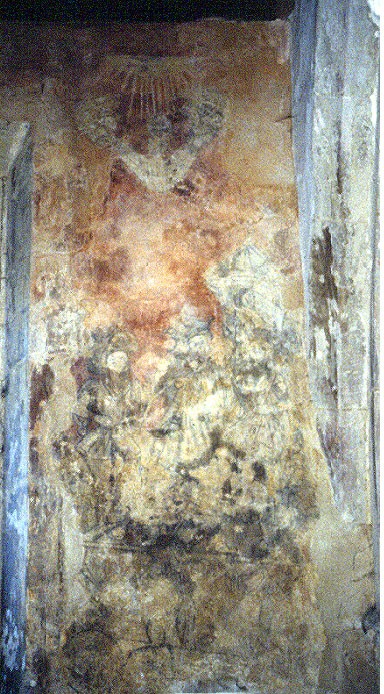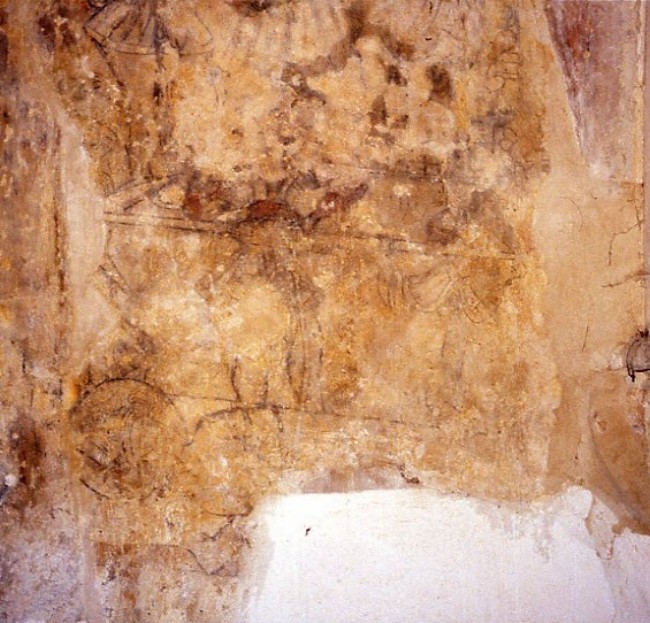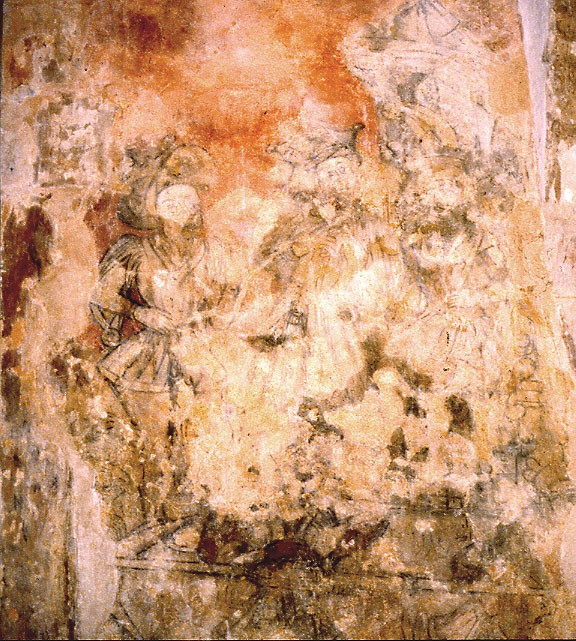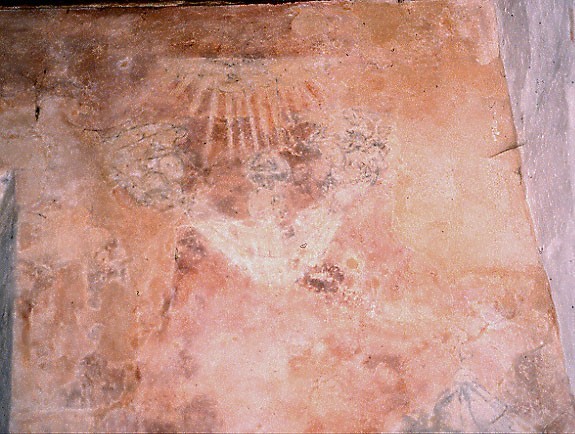Chippenham, Cambridgeshire (†Ely) C.15
The Martyrdom of St Erasmus

The complete scene, shown at the left, looks very unclear, but the photographs of details below should make it easier to see what is going on here. Erasmus (also called St Elmo or Telmo), was a real person, and he may have been a third-century Syrian bishop tortured and eventually martyred under the Emperor Diocletian. He has always been connected with the sea and sailors, hence his association with the ‘St Elmo’s fire’ phenomenon observed at sea.
Hence also his emblem the windlass, the drum-shaped device on which large and heavy ropes and cables can be wound, especially at sea. As in the case of St Catherine’s wheel or St Sebastian’s arrows, this attribute of his martyrdom was not the instrument of his death – like those two saints he was eventually beheaded – although not until he had been tortured in various ingeniously gruesome ways, the final one of which was the winding-out of his entrails onto the windlass which became his attribute.
Below at the left is the lowest part of the painting, showing Erasmus, wearing a bishop’s mitre and with a halo, lying calmly across the horizontal space, with the long narrow ‘rope’ of his intestines pulled upwards onto the drum of the windlass. His arms are tucked behind his back, presumably fastened there (his bent left elbow shows at the bottom edge of the painting). There are some confusing details here, not least the faint remains of the short doublets and legs of two torturers doing the unwinding that eviscerated the saint. But the windlass itself is clearer, with a large red detail in the centre of the actual mechanism, from which the winding-arms radiate outwards like the spokes of a wheel, one of them much longer than the others, presumably to enable maximum force to be exerted.

In the central section above this (shown below right), three richly dressed men stand beyond the windlass, apparently watching the scene with interest The man in the centre is wearing some sort of crown, as is the one on the right, who also has something very reminiscent of a fool’s pointed cap, complete with a bell on the end, emerging from the circle of the crown. He holds some kind of staff in his left hand. The man on the left, the clearest figure, also has odd headgear – a large, strangely-shaped hat, possibly again with a crown over it. He poses with his right hand on his hip, and dangling from his fancy slashed sleeve is something that again resembles a bell. With such a fragmentary painting it is impossible to be sure, but I think there may be a moralising comment here on the ignorant foolishness of those who persecute the saints.¹

At the top of the painting Erasmus’s soul is received into Heaven. This is shown (below left) in a way traditional in art across medieval Europe but seldom found in English wallpainting. At the top is a rayed glory, radiating downwards towards a boat-shaped white swag. This is a napkin, held by the corners at each side by angels, and standing in it, very hard to see now, is a small figure representing the soul of the saint being carried up to Heaven. There are faint traces of the two angels, shown in horizontal flight, with the wings of the one at the left just detectable.²

A rayed glory of a similar type and in a similar context appears again at Gisleham, some 60 miles away on the north Suffolk coast I tentatively suggested a Continental painter’s hand or influence there, but perhaps this is, rather, an iconographical detail peculiar to East Anglia. With so much now lost, no definitive conclusions about this sort of thing are possible.
There is also a St Christopher (forthcoming) at Chippenham, and other fragments of painting, including some illusionistic brickwork and what may once have been a St Michael in the chantry chapel.
¹ Or, as I am becoming more and more convinced, these details might be remnants of a painting of the Three Living and Three Dead, now hopelessly confused with the St Erasmus subject despite being contemporary with it. The three figures look very similar to many of the Living in such paintings.
² Kelly’s Directory of 1929 reports that in about 1896 a painting was found of ‘two angels censing’ – probably those escorting Erasmus’s soul to Heaven at the top of the painting. Samuel Lewis’s Topographical Gazetteer of 1831 records the rebuilding after fire of the church on proceeds from a sale of Indulgences in the 15th century. If Lewis’s information is accurate the paintings were almost certainly part of the refurbishment following this rebuilding.